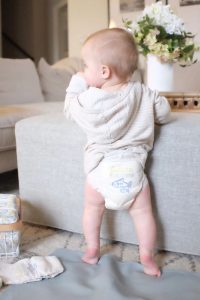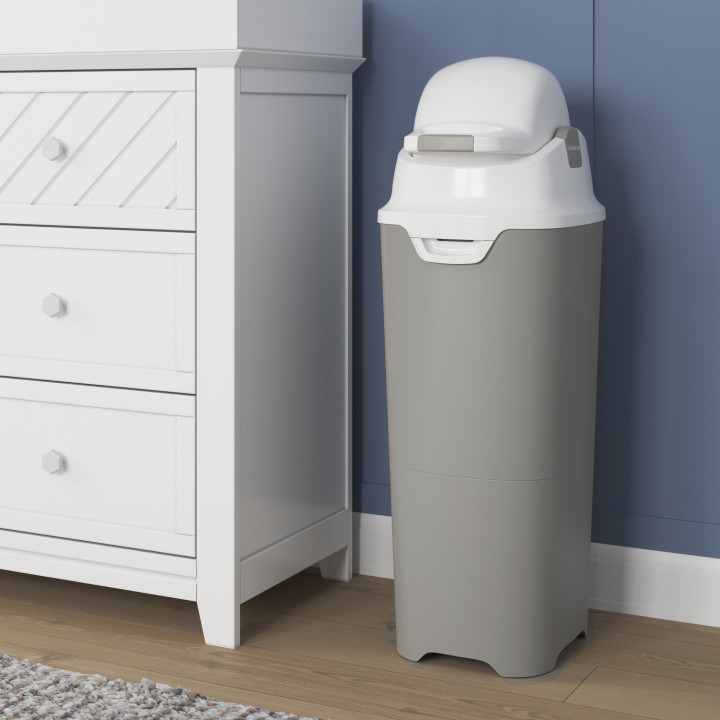When do babies stop wearing diapers? Every parent wonders when their baby will be ready to ditch the diapers. There’s no magic answer, but most children are out of diapers between 18 months and 3 years old. Here’s a look at potty training readiness signs and tips for a smooth transition.
Developmental Milestones for Potty Training
There are several developmental milestones that indicate your child might be ready for potty training. Here are a few to keep an eye on:
Physical Ability:
Your child should be able to pull their pants down and up independently. They should also have some control over their bladder and bowels.
Showing Interest:
Your child might show curiosity about the toilet or potty. They may also start imitating adults using the bathroom.
Expressing Discomfort:
Your child might start to show signs of discomfort in a full diaper. This could be through facial expressions, body language, or vocalizations.
More Signs of Readiness
- Following Simple Instructions: Your child should be able to understand and follow simple instructions related to using the potty.
- Staying Dry for Longer Stretches: Your child might start staying dry in their diaper for longer periods during the day or night.
Creating a Potty-Training Friendly Environment
Here are some tips to create a potty-training friendly environment for your child:
- Get a Potty: Choose a potty that’s the right size for your child. Let them pick out a fun potty seat sticker or decoration to personalize it.
- Practice Makes Perfect: Read books about potty training together. Let your child practice sitting on the potty, even if they don’t go yet.
- Positive Reinforcement: Use praise and encouragement when your child uses the potty successfully. Avoid punishment or getting angry if they have accidents.
Potty Training Tips
- Stick to a Routine: Offer your child opportunities to use the potty at regular intervals, like after waking up, before bedtime, or after meals.
- Make it Fun: Sing songs, read stories, or play a short game while your child sits on the potty.
- Be Patient: Potty training takes time and patience. There will be accidents along the way. Stay positive and consistent.
The Potty Training Journey: Milestones and Individuality
Potty training is a big accomplishment for both child and caregiver. It’s a journey with individual pacing, so there’s no one-size-fits-all answer to when diapers disappear completely. Here are some milestones to look for that indicate your child might be on the path to potty independence:
- Physical Development: Your child should be able to pull down and up their pants or underpants without too much assistance. They should also have some control over their bladder and bowels.
- Showing Interest: Curiosity about the toilet or potty is a great sign! This could involve asking questions, imitating grown-ups, or wanting to see what goes on in the bathroom.
- Communication: Your child might start expressing discomfort in a full diaper through words, facial expressions, or body language.
Creating a Supportive Environment for Potty Training Success
Here are some tips to create a positive and supportive environment that can help your child feel comfortable and confident as they approach potty training:
- Pick a Fun Potty: Let your child choose a potty chair that’s the right size for them. Adding a sticker or decoration can personalize it and make it more inviting.
- Practice Makes Perfect: Read books about potty training together. Let your child practice sitting on the potty, even if they don’t go at first. This helps them get familiar with the routine.
- Positive Reinforcement: When your child uses the potty successfully, celebrate with praise and encouragement. Avoid punishment or getting angry if accidents happen. Accidents are a normal part of the learning process.
Additional Potty Training Tips
- Routine is Key: Offer your child opportunities to use the potty at regular intervals throughout the day. This could be after waking up, before bedtime, or after meals.
- Make it Fun: Singing songs, reading stories, or playing a short game while your child sits on the potty can make the experience more enjoyable.
- Patience is Key: Potty training takes time and patience. There will be accidents along the way. Stay calm, positive, and consistent in your approach.
When to Talk to a Doctor
If you have any concerns about your child’s potty training progress, a doctor’s visit can be helpful. Here are some situations where a doctor’s advice might be beneficial:
- Your child is over 3 years old and not showing any signs of potty training readiness.
- Your child has frequent accidents or seems to be regressing in their potty training.
- **You have concerns about your child’s bladder or bowel control.
Remember, every child develops at their own pace. There’s no set timeline for potty training, so avoid comparing your child to others. When you see the signs of potty training readiness and create a supportive environment, your child will eventually learn to use the toilet independently.
Nighttime Independence and Individual Differences
While daytime diaper use typically ends before nighttime accidents, night dryness can take longer. Here’s why:
-
Bladder Muscle Development: Bladder control develops gradually. At night, the body produces more of a hormone that increases urine production. This can make nighttime dryness challenging for younger children.
-
Deep Sleep: During deep sleep, children may not wake up when they need to use the potty.
Diaper-Free Days and Individual Pace
Some parents choose to use a method called “elimination communication” where they watch for cues that their baby needs to go potty and hold them over a toilet or potty chair. This method can introduce potty awareness early on, but it doesn’t mean diapers disappear immediately.
Remember, every child develops at their own pace. Some children might be out of diapers by 2 years old, while others might take closer to 3 or even 4. The most important thing is to follow your child’s cues and create a supportive environment for potty training success.
Letting Go of Diapers: A Gradual Process
There’s no single answer to “when” because every child develops at their own pace. Here’s a look at the typical timeline:
- Daytime Dryness: Most children achieve daytime diaper independence between 18 months and 3 years old.
- Nighttime Dryness: Nighttime dryness can take longer, sometimes until 4 or 5 years old. This is due to factors like bladder control development and sleep patterns.
Signs of Readiness: Look for these signs that your child might be getting close to diaper freedom:
- Showing Interest in the Potty
- Staying Dry for Longer Stretches
- Following Simple Instructions









